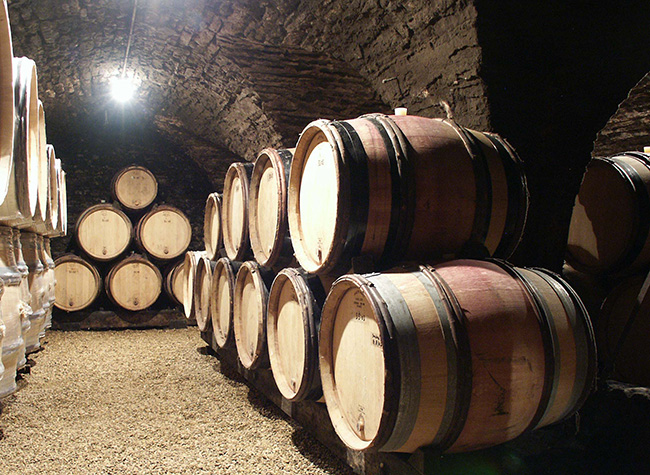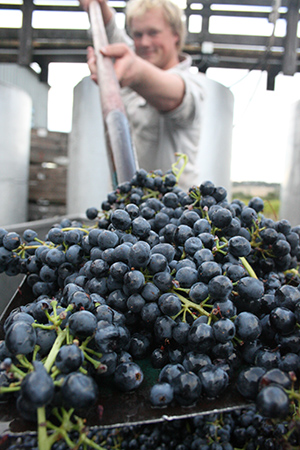Yeah strawberries… not the cheese
Pinot Noir? Hardest game in the world, as Archie from The Fast Show might have opined. Or opinoted. Pinot Noir, the eternal seductress, that most anthropomorphic of grapes, starting with those ineffably regal aromas, the silken torchlight process down your throat and you segue intoxicatedly into the soliloquy, that rhapsody in Burgundy, from Sideways.
It’s thin-skinned, temperamental, ripens early. It’s, you know, it’s not a survivor like Cabernet, which can just grow anywhere and uh, thrive even when it’s neglected. No, Pinot needs constant care and attention. You know? And in fact it can only grow in these really specific, little, tucked away corners of the world. And, and only the most patient and nurturing of growers can do it, really. Only somebody who really takes the time to understand Pinot’s potential can then coax it into its fullest expression. Then, I mean, oh its flavours, they’re just the most haunting and brilliant and thrilling and subtle and… ancient on the planet.
Yes, I went there.

If we were to board the flight of fancy to unalloyed Cote d’Or-shire, then Pinot Noir might truly be said to have transcendence inscribed in its very rainbow genes. Much has been written about the grape, and, in particular, its Burgundian incarnation. Quasi-mystical powers are ascribed to it: with sister Chardonnay, it is the arch terroir-translator, the variety that speaks so eloquently and poignantly not only of the villages and sacred vineyards from which it hails, but even the rows and blocks in which it plants its feet. Once bottled, it whistles its own devilish tune and dances to it. It can be playful and annoyingly capricious. Its nose can be a long as Pinotcchios or shy and retroussé. It may be gamine (not Gamay), kittenish and charming, or serious and profound. It can be light or dark, primary or evolved, the freshness of spring or the decay of autumn, it can be musky, sanguine, medicinal and ethereal. All that jazzapalooza. Above all, it is primal.
But, having said all that, why, oh why, can’t a Pinot be more like a Pinot?
With her velveteen fruit
And Burgundian sheen
Pinot Noir is the grape’s true queen
In Pinot, we invest a lot of anthropomorphic heft.
For far too often, I lever the cork from the bottle housing the abovementioned grape variety, inhale its initial bewitching promise, and then… and then the wine all-too-often slowly degrades, sinking eventually into clunk, clag and cloy. Ripeness seems to topple into confection, background oak moves into the foreground and super-imposes charry notes, the velvet glove is revealed to be encasing a chocolate fist. And alcohol! Wallop. Shiraz-palooza. What is happening? Is it the wine, or is it me? And why?

I am caricaturing the situation, of course. Not every bottle stumbles down this path, but the evolution of the wine from something that promises so much at first sniff and sip to one that is disappointingly lacklustre and devoid of vitality, is one that I have all-too frequently encountered.
By its very nature, Pinot Noir must always dance on the knife edge of balance. And therein lies the inbuilt flaw. Its lucidity may be so easily bruised by clumsy intervention. Oak, for example, must be handled with care so that it does not become a superimposition. Long maceration allied to powerful extraction can rob the wine of its singular personality. It is as if the grape variety lends itself to obtrusiveness.
And changing climatic conditions impose a further burden of viticultural care on the grower.
Pinot Noir is a victim of global warming.
Vignerons, consequently, are having to rethink how they should approach this grape. Good farming, of course, is the key. It is possible that vineyards will have to be planted in cooler regions and at higher altitude.
“Wine to us is a genie, genius loci; our task is to coax it from its stone bottle. Wine’s magical capacity for evoking site, we consider an obligation, as much as a gift. Every gesture we make, in the vineyard and winery, is a summons to the spirit of place. Biodynamics, hand-based viticulture, natural winemaking – these are all means we’ve adopted better to record and to transmit, with the greatest possible fidelity, this spirit’s song.” ~ Mike Weersing

Once the grapes are harvested, there are the usual many options in terms of bringing the wine to the bottle. Using stems to tone down the ripeness is one strategy. Ageing in bigger, more neutral formats would be another.
In the final analysis, Pinot Noir, being the grape variety that we associate with nuance and the beautiful articulation of terroir, requires the gently nurturing hand of a vigneron who is not afraid to disappear into the background. The reality is too many producers succumb to the temptation (perhaps understandably) to make powerful, hedonistic wines, figuring that the market will respect a wine where “more is more.” Thus density and opacity are equated with high quality. But what is more beautiful than transparency? A wine can be strong for being clear, possessing an evident bone structure, for having fruit coiled around a spine of minerality and acidity.
I will continue to drink wines made from this elusive grape variety, but more in hope than expectation. To encounter that true Pinot Noir; I am sure I am not the only one who is dedicated to chalking off this holy wine grail.

